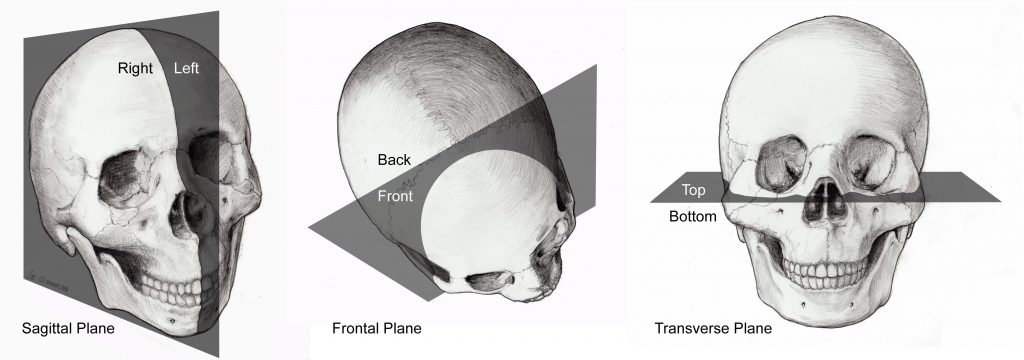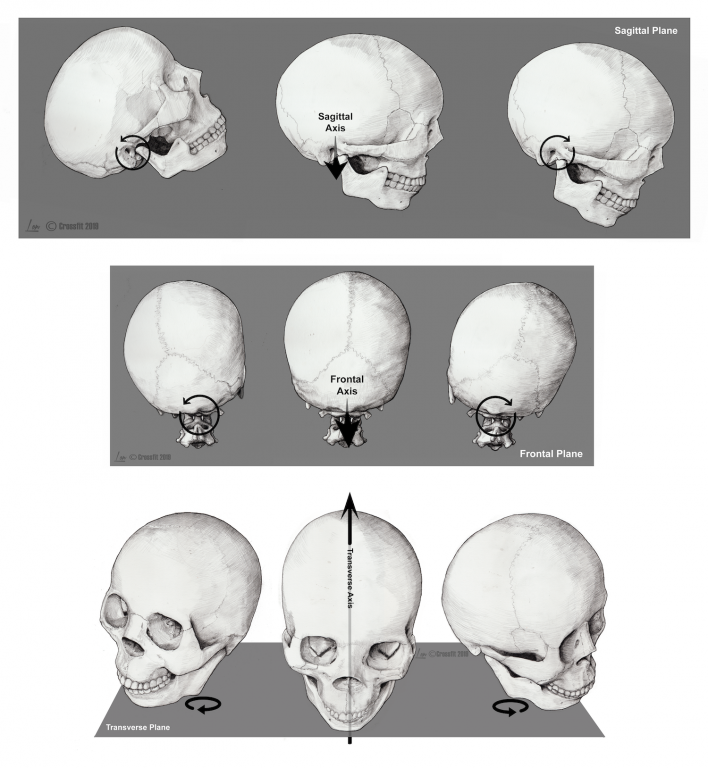The CARDINAL PLANES
One of the first steps in understanding motion is familiarization with the description and definition of anatomical planes. Anatomists use the mathematical concept of planes in describing anatomical features and their locations. A plane is a flat surface—real or imaginary—upon which a straight line can join any two points on the plane.
There are three basic planes used in anatomical description: The frontal, transverse and sagittal planes (Figure 1). These cardinal planes intersect at the body’s theoretical center of gravity or center of mass. This point in space is where the planes dividing the human body’s top/bottom, front/back and left/right halves converge.
The planes are anatomically useful in that they allow one to describe the orientation of a feature relative to an anatomical plane. In keeping with the concept of cartography, you can draw a loose parallel between using anatomical planes to describe the position of an anatomical feature and using latitudes and longitudes to describe the location of a geographic feature on the Earth.
The cardinal planes are easily described:
Frontal—The frontal plane divides the body into front and back halves as it passes side to side (shoulder to shoulder).
Transverse—The transverse plane divides the body into top and bottom as it passes perpendicular to the long axis of the body.
Sagittal—The sagittal plane divides the body into right-hand and left-hand sides as it passes front (toe side) to back (heel side).

-
Figure 1: A sagittal plane (left) divides the body, or a part of it, into right and left portions. A frontal plane (center) divides the body, or part of it, into front and back portions. A transverse plane (right) divides the body, or part of it, into top and bottom portions.
Note that each of the three anatomical planes can be moved and still retain the name associated with its direction of orientation. Think of standing in the shallow end of a swimming pool with the water at about navel level. The surface of the water represents the cardinal transverse plane. If you start squatting down into the water, the surface of the water goes higher on the body. It is still a transverse plane, but it is no longer a cardinal plane because it is no longer dividing the body into equal upper and lower halves. You can do this with all three planar orientations.
AXIS OF MOVEMENT
If you remember your high-school geometry, an axis is an imaginary line around which something rotates. Every “plane of motion” has an axis.
To visualize the axis of a plane and the rotation around it, put a flat piece of paper on the table in front of you. Let’s say the paper represents the frontal plane. Now draw a large human stick figure on it in anatomical position. When looking at the paper now, you are examining the representation of the human (the stick figure) in a frontal perspective. If you place your pen point on your stick figure’s belly button and spin the paper, it is rotating around a frontal axis. The axis of a plane extends perpendicular to the plane.
Now carefully fold that paper in half, the crease running left to right, hopefully at the point where the legs of your stick figure begin. The crease represents an axis of rotation, in this case the rotation of the upper and lower body at the hip. When the top half of the paper is folded down, the upper body has rotated around a sagittal axis. If you fold the paper with the crease from top to bottom you have created a transverse axis.
Part of the body can rotate along a plane around a joint (Figure 2) or the entire body can move along a plane. The axis of a plane extends perpendicular to the plane (sticks out from each side as it goes through the plane).
A perfect cartwheel would be an example of the body moving along the frontal plane. To rotate in the sagittal plane, the body will rotate around an axis that protrudes from the sides of that plane. A forward somersault would be an example. To rotate in the transverse plane, the body will rotate around an axis protruding from the transverse plane. An example is the rotation of the body in an axel jump in ice skating.
